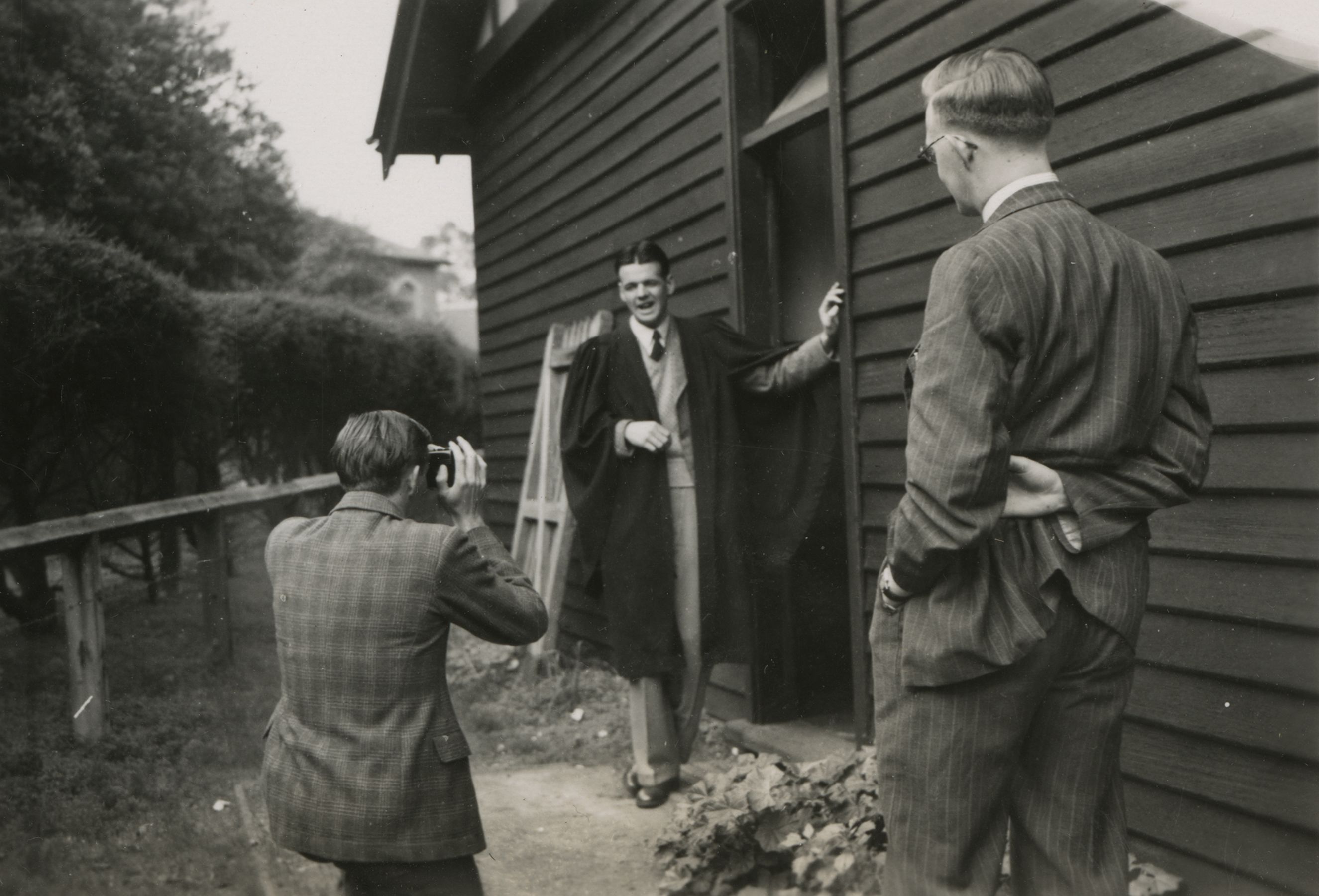'Let there be a new wing ...'
The Wooden Wing

Almost two decades after its construction, a student writing in a 1940s' Fleur-de-Lys observed with due irony that 'it is an unwritten law in the building trade that a Temporary Wooden Structure costing more than a thousand pounds is temporary in name only.' So it was proving to be for Trinity College's 'Wooden Wing'.
At the close of the First World War, the College found itself grappling to deal with a high demand for places, as returning servicemen sought to resume tertiary studies at the University. An appeal in 1919 raised £10,000 towards the erection of a new building, but the need for immediate accommodation was urgent. In haste, the Rusden Museum in Upper Bishops' was converted into a dormitory for six new students. Several students who shared double studies in Clarke's gave up their sitting rooms and took in a third student to try to ease the pressure.
It was evident, however, that such measures were only short-term solutions. In July 1919 the College Council referred the issue to the Executive and Finance Committee with authority to act on a more substantial, albeit temporary, accommodation solution.
Within a few weeks the committee resolved to allocate £1500 towards the construction of temporary accommodation, with plans and tenders to be advertised. Melbourne City Council approved an application for the erection of a temporary wooden building. While funding was subsequently increased to £1800, by the time of its completion, the Wing – including furnishing, covered by a £960 anonymous donation – had cost £3000.
By November 1919, the situation was becoming acute. The recently installed Warden, (later Sir) John 'Jock' Behan, had already received 93 applications for admission in 1920.
Behan proposed to the Council that he and his wife would move out of the Warden's Lodge (Leeper building) and into a pavilion, to be erected in the gardens. The Council thanked him for his generous offer, but determined instead to proceed with the erection of a temporary wooden wing. It was also decided to convert the old chapel (now the Warden's office) and the Rusden Library (now the Perry Room) into studies for the course of 1920.
Clements Langford of Melbourne undertook construction and the Wing was completed at a breakneck pace in sections. Students returning to College after the summer break of 1919–20 found that in their absence, 'a wondrous edifice made its appearance on the north side of Clarke's.'
View from the towering turrets of neighbouring Ormond College, the Wooden Wing (lower right) spoke directly to the post-war challenges faced by Trinity.
Trinity College Archives, MM 000002

Its visible similarities to an army barracks fostered rumours of a military past, with the popular slur being that it had been an army hospital for venereal disease during the recent conflict.
Even as late as the 1960s, it was described as 'the World War I Army hut known to generations of Trinity men as the Wooden Wing'.
The additional accommodation – housing a further 23 students and a tutor – boosted the number of students in residence to a record 82. A satirical article entitled 'The First Book of the Prophet Bulshimiah' in the Fleur-de-Lys magazine heralded the building's construction under Behan:
And behold in the third year of his reign he said unto the people, 'Let there be a new wing.' And he gathered together many carpenters, and set men over them, to be their foremen – and behold there was a new wing. And John, which is also called Willie was exceeding proud, and he said unto the people, 'Behold what I have.' But certain lewd people of the baser sort mocked at him, and likened the wing unto a fowlhouse and a monkey cage – yea, and even unto an hospital at Abbassea in the land of Egypt.
The Wing was always intended as a temporary measure with the Council permit being for a temporary structure to remain until the end of 1921.
A new 'Peace Wing' was planned and partially funded to replace the accommodation then being provided by the Wooden Wing. The Peace Wing never eventuated, and the Wooden Wing lingered well beyond its earlier intended tenure.
A fresher student poses for a photograph at the entrance to the Wooden Wing, 1947
Trinity College Archives, MM 002625

The Wing was plain and functional and comprised 24 rooms – 12 either side of a central corridor, with showers at one end. It projected north from the back of Clarke's building, past the tennis courts at Janet Clarke Hall where the women of Trinity were housed.
Despite its 'temporary' nature, the Wooden Wing's construction was relatively robust, and a far cry from the corrugated iron-skinned army barracks it resembled.
Rooms were of uniform size with a low window that made escapes easy at the approach of the Warden.
The doors had a single pane of thin frosted glass, offering no resistance to any number of missiles that might hurtle down the corridor's length. As one student of the late 1950s recalled, 'Toilet and washing facilities were of the most primitive variety and the combined fumes of alcohol, tobacco and, occasionally and exotically, incense, availed little in drowning the malodorous effusions of the Wing's uniquely inefficient urinal'.
The Wing's walls were a continual source of combined puzzlement and amazement that they continued to support the roof. 'Those walls were perhaps the Wooden Wing's most singular architectural feature', one student remembered. 'Although one could not see through them they resisted very little else'.
College students – particularly those whose accommodation was in the brick and mortar buildings of Bishops' and Clarke's buildings – regarded the Wing's walls with some suspicion.
The women students – the 'Hostiles', from Trinity's neighbouring Women's Hostel, Janet Clarke Hall – eyed the building over their back fence derisively. They dubbed it 'the caterpillar', with a distinct lack of affection.
Borrowing from William Blake's 1794 poem, 'The Tyger', one college wit characterised the new residential wing in 1920, penning the following verses:
Caterpillar, long and low,
There is no Hostile but would know
What misguided hand or eye
Could frame thy fearful symmetry.
In the darkness of the night
Squat, sinister, and patched with light;
By day, if possible, more hideous
You would offend the least fastidious.
Each fresher in his cell-like room
Must live a life of deepest gloom.
The ugliness they strive to hide
With bath-towels draped alone they side.
When the builders drove away
And left thee naked to the day,
Could they smile their work to see?
Could he who built the Lodge build thee?
Caterpillar, long and low,
I dare not guess, I would not know
What misguided hand or eye
Dare frame they fearful symmetry.

In the late 1920s, Francis Denys Cumbrae-Stewart demonstrated that a bullet fired from one end of the building could pass through no fewer than ten walls and out the other end with very little deviation to its trajectory.
The Cumbrae-Stewart Memorial Bullet Hole was a much sought-out shrine for incoming students on the walls of the Wooden Wing, until far too many other projectiles had made their own marks as to make the Memorial Bullet Hole too difficult to locate.
Not unexpectedly a close sense of camaraderie soon developed among the 'Wingers', somewhat to the envy of those unable to share in the experience. 'The beds were not, perhaps, the most comfortable in College', it was later remarked, 'but they were admirably mobile':
One belonging to Mr J.Feltham, then the Wing's Tutor, found its way to the top of shower stall after the Valedictory Dinner in 1957. The bed's coverings, being even more mobile, dispersed themselves in defensive position on the woodheap and the roof.
Retrieving his bed, Feltham had it nearly to the floor of the bathrooms when it slipped, 'gave a sudden lunge and pinned him to the wall'. The crowd of onlookers with their well-meaning advice quickly departed, leaving the helpless Feltham to call upon passers-by to come to his aid.
While an increase in student numbers during the 1930s created an ongoing need for the Wing, the drop in student numbers at the outbreak of the Second World War meant that all students could be accommodated throughout the College's permanent buildings and the Wing was closed for a time. The RAAF School of Administration had the use of Clarke's building and the Wing until the end of 1944.
Looking south towards Clarke Building as the Wooden Wing comes down, 1962.
Trinity College Archives, MM 003045
The Wooden Wing during demolition, as seen from neighbouring Janet Clarke Hall
Trinity College Archives, MM 003044
Trinity's overseer Syd Wynne takes to the window architraves during the building's demolition in the summer of 1962.
Trinity College Archives, MM 003050
A last glimpse down the Wing's long corridor. The 12 bedrooms either side were the first experience many students had of Trinity College for almost half a century.
Trinity College Archives, MM 003047
Not particularly missed from an architectural point of view, the greatest loss for freshers was that they 'have been unfortunate in missing its corporate atmosphere'.
Having out-lasted the ever-present threats from the College Council, the encouragement of the second Warden to 'burn down the Wooden Wing' (even with the reminder that 'the penalty for arson is death'), a world war, and the miscellany of attempts by students to bring the building to its knees, many had come to accept that the Wing had become all but a permanent presence at College.
In December 1950 , an enquiry into the future of the Wooden Wing 'suggests merely that it is there forever, and will probably turn out to be Atomic bombproof'.
It came, therefore, as a surprise, when the Wing seemed to offer so little resistance to the teams of workman who dismantled it during the summer vacation of 1963.
After the building had come down, a large pile of brown hair remaining perplexed many, until it was ascertained that it was the accumulation of forty years' worth of cows that had rubbed themselves against the Wing's weatherboards.
And then it was gone.
The timber packed on trucks and carted away, the only vestige of the Wing being its urinal that lingered slightly longer on the site – a fitting final memorial, as it was the aspect of the Wing remembered most on hot summer days by students.
Having suffered for 40 years the repetitive humour and brute violence of Trinity’ s freshmen, she rests at last in Greensborough, among the gums from which she sprang.
The Wooden Wing in its final last stand, during demolition during the summer break, 1962-63.


Dr Ben Thomas, Rusden Curator, Cultural Collections curator@trinity.unimelb.edu.au





